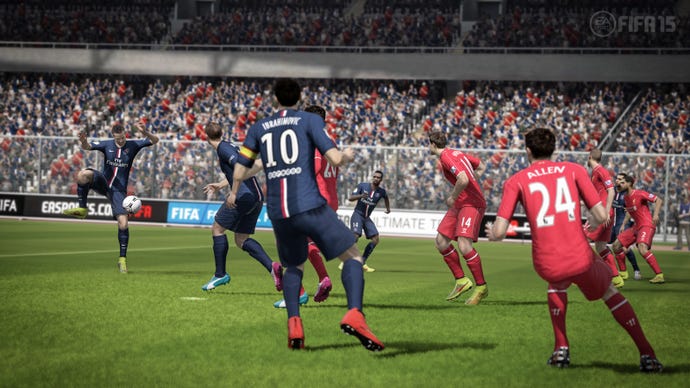FIFA 15 guide: build the best hybrid squad in Ultimate Team
Make building a winning hybrid squad in FIFA Ultimate Team a lot easier with our in-depth advice and tips.
FIFA 15 guide: build the best hybrid squads in FIFA Ultimate Team
Building a hybrid squad of McBusted stature is one of FIFA 15 Ultimate Team mode’s greatest challenges. Creativity is often lacking in this mode—‘Oh cool, you’ve got Daniel Sturridge, Theo Walcott and Loic Remy breaking the speed barrier up front’—but there’s an awful lot of room to experiment with unique teams.
"When created intelligently, unlikely unisons can work spectacularly. Passes zip, gut-wrenching runs become more incisive and you’ll realise you’re in love."
In fact, using hybrids has quickly become a lost art in competitive online play. Quite often, the most original squads only show themselves in the single match arena, as owners become too hesitant to trust their concoctions against the tried and test Premier League, La Liga or Bundesliga sides.
When poorly constructed, hybrid teams struggle to make simple passes, fail to exploit space and generally lack the tempo needed to maintain momentum in your favour. The ground becomes thicker, as do your players. When created intelligently, unlikely unisons can work spectacularly, taking inspiration from that monster Mel C and Bryan Adams hit from 1998. Passes zip, gut-wrenching runs become more incisive and you’ll realise you’re in love.
As convoluted as building hybrid squads can be, winning with a team you have endeavoured to create away from traditional one nation/league line-ups is up there with FUT15’s most satisfying achievements. It’s a tricky process—one which requires plenty of trial and error—but a handful of simple tips can make the task easier.
100% chemistry
Hybrids provide you with the opportunity to conglomerate the best players and strengths of multiple leagues in a single formidable package. Think Arjen Robben’s cultured left with Cristiano Ronaldo’s proflic right: they don’t naturally link on the game, but they can provide unyielding devastation if the players between them form an effective chain. Individual chemistry links are most important here, as the positioning of three or four key players will dictate how the rest of your side performs. For example, take a look at my design:
Three leagues, four nations, six clubs. Most critically, 100% chemistry is achieved and there’s no dead links between players (more on this later). We have the brutality of the Premier League linked with La Liga’s technical wizardry, not to mention the appearance of a Ligue 1 striker who is certain to land himself a big money move in the coming years. How then, is such a diverse selection achieved?
Take a look at Mathieu Flamini and Aaron Ramsey. Two Arsenal midfielders whose nationalities allow this 3-5-2 formation to expand its horizons either side of their central midfield positions. Slot a third Arsenal star in Per Mertesacker behind them and the option for creativity shows itself, as three nations from the same club playing through the centre means diverse choices can play on each wing.
Saving coins
For this particular formation, it is best to look at the side in two symmetrical halves. Both Flamini and Ramsey are linked to wingers of their own nationality who play in La Liga. Behind them is a defender of the same country and league (Eliaquim Mangala for Flamini, Ashley Williams for Ramsey), who wouldn’t provide a green link with the other midfielder in question. Mertesacker is the constant to give both a chemistry boost, but it’s the left and right-sided centre-backs who provide a tailor-made springboard for bringing in talents from other divisions.
Vitally, these players maintain a positive link to their aforementioned Premier League buddies. Gareth Bale, seen on the right of midfield here, isn’t going to enjoy decent chemistry with anyone outside of La Liga unless they are Welsh. Ramsey and Williams make him part of the team without creating a broken link. This means experimentation can now be utilised ahead of Bale, as his only attacking link leads straight to the striker. It’s important to capitalise on this. Bale is available to loan in the EA Sports Catalogue, so I’ve allowed one of the game’s best players to excel via a green link to Karim Benzema, his Real Madrid club mate. As I detailed in my previous tips piece on how to build cheap sides, smart builders utilise the catalogue offers to bring in players they wouldn’t necessarily be able to afford otherwise (Ramsey is also currently available through these means). You’ll save coins and be able to try the best for a fraction of the standard coin price.
Ramsey isn’t judged on his relationship with the attack, so any La Liga striker can be slotted in ahead of Bale to ensure the hybrid lives up to its name. I’ve plumped for Benzema due to the reasons previously outlined and with the knowledge that I wish to bring Lyon’s Alexander Lacazette into the other striker’s role without dabbling further into Ligue 1.
Hybrids provide the intriguing opportunity to build teams around individuals you favour. While I love to deploy Lacazette, I’m not fond of the other options available in the French top flight. It is in this situation that hybrid squads are particularly useful. I can use the player I want without committing to a division which struggles for strength across the entire pitch.
However, workable links are great on the surface, but you also need to ensure the team plays how you want.
Cast your eyes back to my squad once more. Antoine Griezmann’s positioning on the left makes less sense than placing Samir Nasri there, as the latter would share a perfect green with Mangala. Nasri lacks explosive pace and isn’t able to track back as hastily as my selection, making him a poor choice when using three defenders. Griezmann offers the energy, incision and pace needed to support all phases of play on the left side; a vital ingredient when setting up with minimal numbers at the back.
Laurent Koscielny would also be more prolific in terms of chemistry than Mertesacker, but his medium/high work-rates will see him create too much space alongside Williams. Mertesacker stands tall with a medium/medium output, allowing Mangala’s high/high to push on and Williams’ medium/high to act as sweeper when high balls come over the top. Although Williams’ work-rates mimic
Koscielny, playing both together would see this line drop unnaturally deep, opening a ravine for your opponent to exploit in front of the halfway line.
Versatile work-rates are particularly key in hybrid squads. Considering many individuals won’t share the green links of simple sides, you need to ensure all areas of the pitch are naturally filled by at least one player. Never take individuals for granted. An overdependence on identical work-rates in similar areas can make your style easy to predict and counter.
"Many FUT15 users will render anyone with low work-rates useless, but this simply isn’t the case."
While Flamini and Ramsey are both high/high, this is favourable when using three at the back, as one will generally provide defensive support while the other breaks forward (particularly if your team emphasis remains balanced). This works behind Charles N’Zogbia, whose medium/low work-rates in central attacking midfield keep him stationed behind the strikers. Many FUT15 users will render anyone with low work-rates useless, but this simply isn’t the case.
As seen here, N’Zogbia is able to maintain possession and use his pace to aid the two marksmen, without wasting energy tracking back. He provides an outlet which offers respite on the counter, an essential component of keeping pressure away from defence in this particular formation. The Aston Villa man also ticks two boxes—being French and a Premier League representative—making him the natural choice to sit between the midfield and attacking lines. Sometimes, hybrid building can fall into place.
Green links allow you to have a red link elsewhere without significantly denting your chemistry. I personally prefer to ensure every individual has a “working” relationship with the player next to them, but red links can push experimentation further without restricting your overall effectiveness.
Take a look below (note: a La Liga manager pushes this squad’s chemistry up to 100):
This slight line-up change allows Ronaldo into the team, but subtle alterations have been made to fit him in (removing two clubs and one league, in this instance). The team might not work as well on an individual level—Abou Diaby isn’t a particularly inspiring attacking midfielder—but the added firepower of Ronaldo is likely to more than make up for it. These sides are often built to facilitate star players at the expense of others, so if you have a favourite, work around him.
Hybrid experimentation is infinite. It is also the only method in FUT15 where you can take total control over a squad that looks to bend the game’s chemistry ruler without shattering it. The most destructive sides will hit that magic 100 while seamlessly interlinking players who have no real-world connection. Imagine Michael Jackson as the lead singer of the Rolling Stones heading to Central Perk to perform with Phoebe Buffay; it doesn’t make a whiff of sense, but the potential quality on offer would ensure a unique synergy that may just be the best thing ever.












